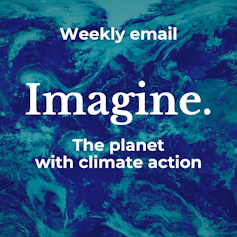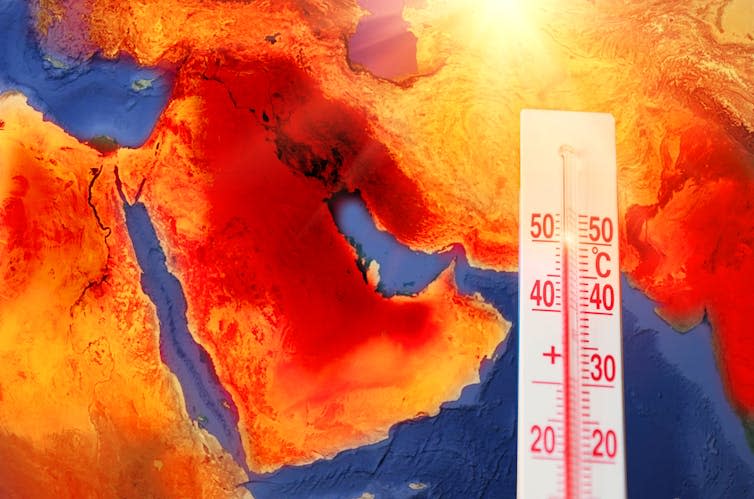A reckless experiment in Earth’s atmosphere caused a desert metropolis to be flooded.
That was the story last week when more than a year’s worth of rain fell in one day on the Arabian Peninsula, one of the driest regions in the world. Desert cities such as Dubai in the United Arab Emirates (UAE) suffered flooding that inundated highways and airport runways. 21 people were killed in the UAE and Oman.
The heavy rain on Tuesday, April 16, was initially attributed to ‘cloud seeding’: a method of stimulating precipitation by injecting clouds with small particles to which moisture can attach – those droplets then merge and multiply. As the water receded, however, a more disturbing explanation emerged.

This summary of The Conversation’s climate coverage is from our weekly climate action newsletter. Every Wednesday, The Conversation’s environmental editor writes Imagine, a short email that delves a little deeper into just one climate issue. Join over 30,000 readers who have subscribed.
Richard Washington, professor of climate science at the University of Oxford, has seen the inside of a storm. To confirm whether cloud seeding is really possible bring record-breaking rainhe once boarded a plane bound for a storm cloud over the South Africa-Mozambique border.
Read more: Don’t blame Dubai’s strange rain for seeding clouds – the storm was far too big to be man-made
“Our mission was to fly through the most active part of the storm, measure it, fly through it again while dumping a load of dry ice, turn hard and fly through for a final measurement,” he says.
“Other than the joy of flying through the core of a thunderstorm in a Learjet, I didn’t think much about the time I was lucky enough to be part of that project. Until I heard about the recent storm in Dubai.”
What caused the flood?
There are no two identical clouds to compare the outcome of seeding with, Washington says, so it’s impossible to prove whether this technique can change the outcome of a single storm. But by flying many missions, half with cloud seeding and half without, and measuring the rain between the two, meteorologists eventually showed that cloud seeding affected rain rates in some storms.
However, that is not the cause of the floods in Dubai.


“It turns out that the UAE has been running a cloud seeding project for several years, the UAE Research Program for Rain Enhancement Science. Their approach is to fire hygroscopic (water-attracting) salt flares from aircraft into warm cumuliform clouds,” says Washington.
“So could seeding have created a massive storm system the size of France? Let’s be clear: that would be like a breeze stopping an intercity train at full speed. And the sowing flights had not taken place that day either. The kind of deep, large-scale clouds that formed on April 16 are not the purpose of the experiment.”
For Washington, the more relevant atmospheric experiment is the one that each of us engages in every day.
“Interestingly, people find it difficult to come to terms with the fact that 2,400 gigatons of carbon (our total emissions since pre-industrial times) could make a difference to the climate, but very easily get behind the idea of a a pair of hygroscopic torches ensure that 18 months of rain falls in one day.”
The experiment of our lives
A warmer atmosphere holds more moisture, which can fall as rain. Although last week’s deluge was unusual, the Arabian Peninsula tends to receive more precipitation in heavy bursts than in steady showers.
The latest assessment by the Intergovernmental Panel on Climate Change (IPCC) did not predict future rainfall trends for the region, but did say global warming is expected to make such violent downpours more frequent and intense.
What is likely to kill more people as temperatures rise in this part of the world is not water, but heat. Tom Matthews (Loughborough University) and Colin Raymond (California Institute of Technology) are scientists studying the changing climate and its effect on our body.
Read more: Global warming is now pushing the heat into an area that humans cannot tolerate
Throughout human evolution, wet bulb temperature (how hot it is when you subtract the cooling effect of evaporating moisture, like sweat on your skin) has rarely, if ever, exceeded 35°C. At this threshold, the air is so hot and humid that you cannot lower your temperature to a safe level by sweating. You overheat and without emergency medical attention you die.
“The frequency of severe wet bulb temperatures has more than doubled globally since 1979, and in some of the hottest and most humid places on Earth, such as the coastal areas of the United Arab Emirates, wet bulb temperatures have already dropped past 35°C.” Matthews and Raymond say.


“The climate envelope is pushing into an area where our physiology cannot follow.”
Alarmed by the rate at which we are making the climate unlivable, some scientists have called for emergency action. Peter Irvine, lecturer in earth sciences at UCL, suggests the dimming of the sun by pumping microscopic particles into the upper atmosphere to reflect some of the rays.
Read more: Why dimming the sun would be an effective tool in the fight against climate change
Trying to recreate the cooling effect of a volcanic eruption, but on an ongoing basis (until greenhouse gas concentrations can presumably return to safe levels) is a gamble with the atmosphere. These layers of gases surrounding our planet have nourished life by keeping temperatures stable and blocking out harmful radiation.
Irvine acknowledges that keeping the Earth artificially cool in this way is risky, but says the side effects – such as altered wind and rain patterns, acid rain and delayed recovery of the ozone layer – “pale in comparison to the consequences of climate change”.
Catriona McKinnon, professor of political theory at the University of Reading, has other concerns trying to control solar radiation in this way, including the question of who has the right to regulate the global thermostat.
Read more: Time is running out on climate change, but geoengineering has its own dangers
While humanity contemplates another massive experiment in our atmosphere, there is another, even grander experiment waiting to be resolved. The solution is simple: stop burning fossil fuels.
This article is republished from The Conversation under a Creative Commons license. Read the original article.

